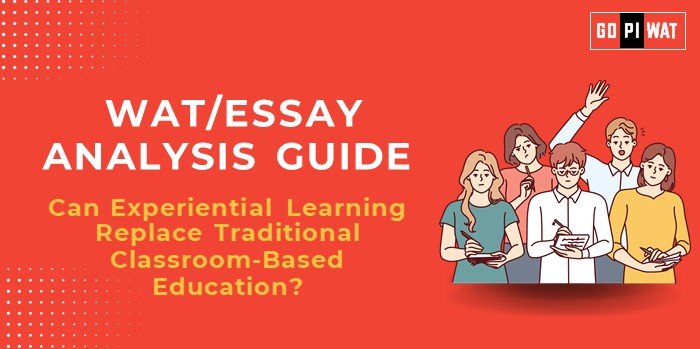📚 Can Experiential Learning Replace Traditional Classroom-Based Education?
🌟 Understanding the Topic’s Importance
This topic explores evolving education models, focusing on how experiential learning links directly to leadership, adaptability, and real-world problem-solving skills. These elements are crucial for modern education and B-school success. By analyzing the potential of experiential learning to replace traditional methods, we address how education can better prepare students for real-world challenges.
📝 Effective Planning and Writing
- ⏱️ Time Allocation:
- Planning: 5 minutes
- Writing: 20 minutes
- Review: 5 minutes
- 📖 Preparation Tips:
- Collect examples of hybrid models combining experiential and traditional methods.
- Note statistical evidence supporting retention, engagement, and skill application improvements.
✍️ Introduction Techniques for Essays
- ⚖️ Contrast Approach: “While experiential learning fosters real-world skills, traditional classrooms build strong theoretical foundations. The balance remains a debate.”
- 💡 Solution-Based Approach: “As education evolves, blending experiential and traditional methods could redefine learning outcomes.”
📚 Structuring the Essay Body
🏆 Achievements:
Highlight the success of experiential learning approaches:
- 📈 Retention Rates: In the US, project-based learning increased STEM student retention by 30%.
- 🔧 Skill Application: Real-world problem-solving exercises enhance critical thinking and adaptability.
- 🌍 Global Examples: Programs in Finland and Singapore show improved student engagement through blended learning models.
⚠️ Challenges with Comparative Analysis:
Address hurdles in adopting experiential learning:
- 💻 Infrastructure Limitations: Developing economies struggle to implement experiential methods due to resource constraints.
- 💡 Scalability Issues: Experiential learning often requires smaller student-teacher ratios and specialized equipment.
- 🎓 Theoretical Foundations: Experiential methods alone may not provide sufficient depth in theoretical understanding.
🔮 Future Outlook:
Propose hybrid models as the way forward:
- 🖥️ Technology Integration: Hybrid models leveraging AR/VR can create scalable, immersive learning experiences.
- 🤝 Public-Private Partnerships: Collaboration between governments and EdTech companies can lower costs and increase accessibility.
- 🎓 Teacher Training: Investing in teacher preparation for experiential methods ensures effective implementation.
✅ Concluding Effectively
- ⚖️ Balanced Perspective: “A synergistic approach integrating experiential and traditional learning methods is vital for the future of education.”
- 🌍 Global Examples: “As seen in Finland and Singapore, blended models ensure inclusivity and efficacy.”
🔍 Analyzing Successes and Shortcomings
- ✔️ Key Achievements: Improved retention rates, enhanced skill application, and greater engagement.
- ❌ Ongoing Challenges: Infrastructure gaps, cost barriers, and difficulty scaling experiential learning to large populations.
- 🌏 Global Context: Success stories from developed nations offer replicable frameworks for other regions.
🔑 Recommendations for Sustainable Progress
- 👩🏫 Teacher Training: Equip educators with the skills to implement experiential methods effectively.
- 🤝 Foster Public-Private Partnerships: Provide affordable tools and resources for experiential learning.
- 📘 Emphasize Hybrid Models: Blend traditional and experiential methods in policymaking to maximize benefits.
✏️ Sample Short Essays
- ⚖️ Balanced Perspective: “Experiential learning excels in skill development, but it cannot wholly replace classroom education, which builds theoretical rigor.”
- 💡 Solution-Oriented: “Integrating experiential methods with traditional systems can enhance both retention and foundational knowledge.”
- 🌍 Global Comparison: “Blended learning models in Finland and Singapore prove the importance of balance between experiential and theoretical approaches.”


